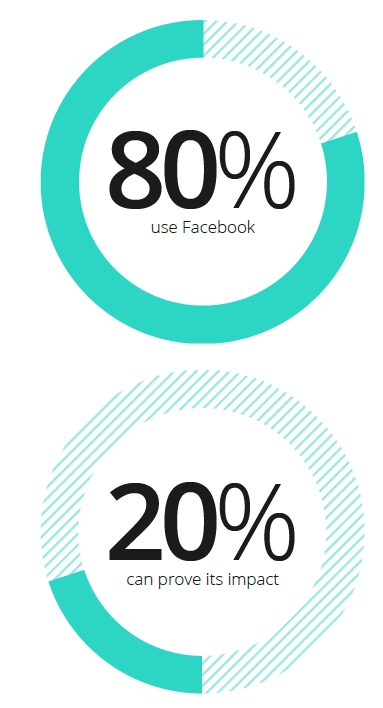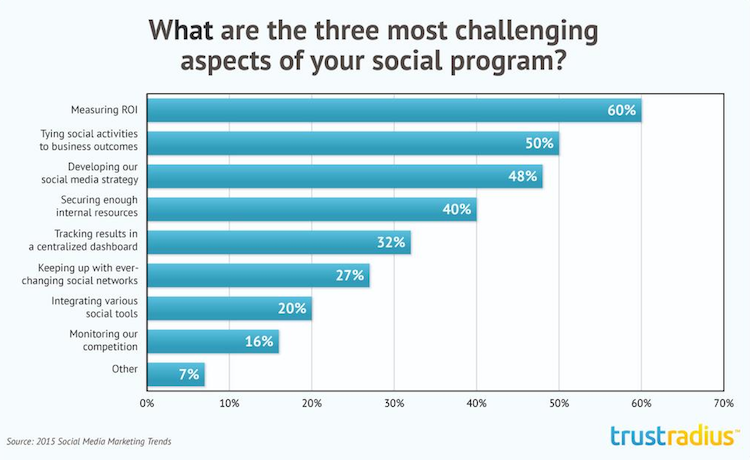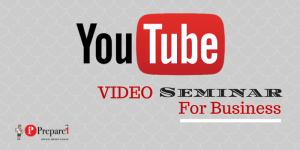
Do you measure your social media return on investment?
Is that return important to you and your business?
Social media ROI is one of the most heavily debated topics in the online marketing world. Why? Because measuring the effectiveness of social media marketing efforts isn’t as clear cut as, say, running a Google AdWords campaign. It’s hard to tell how much revenue a Tweet you sent out last week brought in, or if your last Instagram post boosted your bottom line.
And judging by the numbers, a lot of businesses are struggling to grasp the financial impact social media marketing is having for them. In a survey from Convince & Convert, 41% of companies said they had no idea whether or not their social media efforts were actually paying off.
A separate study gives some insight as to why companies aren’t measuring their social media ROI. This survey looked at some of the specific challenges companies are having when it comes to measuring the value of their social media marketing efforts.
- 56% said an inability to tie social media to business outcomes
- 39% said a lack of analytics, expertise and/or resources
- 38% said poor tools
- 35% said inconsistent analytical approaches
- 30% said unreliable data

WHAT IS SOCIAL MEDIA ROI?
The definition will depend on what your organization’s objectives are—brand awareness, revenue, customer satisfaction, etc. But generally speaking, social media ROI is the sum of all social media actions that create value. After all the time, money, and resources put in—what’s the return?
If you were measuring ROI by revenue, for example, a simple formula to do that looks like this:
Profit / total investment (people hours, ad budget, etc.) X 100 = social media ROI (as a percentage)
So, if you made $1,000 in revenue from social media on a $500 investment, your profit is $500 (remember: profit = revenue – investment). And then your calculation would be: $500 profit / $500 investment X 100 = 100% return on your investment.
Not every organization will be able to attribute revenue directly to social media. Value isn’t always measured in dollars and cents. Tethering the ROI of social media to such a narrowly defined objective prevents you from identifying the many other ways your investment in social is paying off.
If your goal is to drive brand awareness, you would measure success against metrics such as audience reach and engagement, not profit.
DEMYSTIFYING SOCIAL ROI
If you can’t show the value social adds to business and brand results, you’re at a disadvantage.
ROI isn’t just doing better on Facebook.
Boosting video views on Facebook or building a bigger Instagram audience might win awards. But it doesn’t (necessarily) correlate with higher revenue, lower costs, or compelling brand differentiation.
Every year, the effectiveness of traditional media declines. At the same time, the influence of everyday experts—like customer advocates, YouTube experts, and peers on social media—continues to climb and influence how consumers discover and buy.
ASKING A SMARTER ROI QUESTION
What’s the ROI of our social presence? It’s a common question. But one that keeps you stuck at guesswork.
To solve the ROI puzzle, you need to be specific about what you want to achieve with social media.
• What business challenges do you want social to help solve?
• How will you map your business objectives to social KPIs?
• Did you hit your quarterly business goals? If so, what contribution did social make?
Until you’ve answered those questions, it’s difficult to “prove” social media ROI.
1. Define
What do you want social to solve?
It’s your job to define the business objectives for every marketing channel—including social media.
Be clear that you expect social to help solve tangible business challenges such as beating revenue targets, lowering operational costs, increasing efficiency, differentiating your brand, or increasing customer satisfaction.
2. Measure
Is social moving you towards your business targets?
Next, set targets for the social team and get them to start tracking against those goals. Make these goals time-bound with clear targets (such as “social channels are expected to deliver 5,000 attendees to our yearly conference”). In this phase, you can now see if your social strategies are helping
you achieve real business outcomes.
For example, if your business goal is to increase customer loyalty, the social team should be tracking metrics like LTV attributable to social content and average shopping cart transaction value. If the goal is to reduce customer service costs, the social team can quantify call deflection cost savings by answering customer questions and sharing content on social.
As these KPIs are mapped to business objectives, it will be easy to keep your team’s eyes on the bottom line. If top-line sales have slipped but the social team sends you glowing reports of increases in Facebook traffic, it’s easy to see that social tactics and business outcomes have become disconnected.
Refine your social strategy and metrics to get back on course.
3. Prove
Did you hit your business goals?
You’ve defined what social can help solve. You’ve mapped social metrics to specific business outcomes. And now, because you’ve created a clear expectation for social media, you properly measure the value.
Frame your ROI analysis with three questions. Did your organization achieve your business goals (the ones you decided social could help solve)? If yes, what social tactics were successful in helping the company reach those goals?
If no, how can we tune our social strategy to hit these goals next quarter?
TOOLS TO HELP YOU
You probably noticed that you don’t have to use a ton of tools to do this. We’re keeping it scrappy and lean! Here’s a quick recap of the tools I’ve mentioned:
- Google Analytics: To track your campaigns and goals
- Google URL builder: To assign trackable links for your campaigns
- Hootsuite: To schedule your social media posts
- Customer LTV Calculator: To calculate the LTV of your customers
GOAL SETTING IN GOOGLE ANALYTICS
Setting up goals is going to be your first step in using Google Analytics to track your organic ROI. Goals are a way to have Google Analytics record conversions that are being generated from social media.
What are conversions? Conversions are an event that is triggered by a customer, audience member or fan following through with an action that you wanted them to take. Conversions can be anything from:
- Buying a product
- Signing up for an email list
- Subscribing to your podcast
- Downloading an e-book you wrote
This list could go on. Here’s a good blog post by Coschedule on how to:
Setting up goals in Google Analytics allow you easily track those conversions and prove to your team that the messages that you are sending out on your social media channels are driving your customers to take action.
A common headache
I’ll start with the stats. There are loads of studies which show that marketers struggle with measuring ROI from social media.

Obviously just because something is hard to achieve that doesn’t mean it’s impossible or not worth the effort, but equally it does mean those who manage budgets are within their rights to question whether social media is worth the money.
FINAL THOUGHTS
Once you have your stats in front of you, you can calculate your ROI and review the results of your marketing to see what worked and didn’t work. If you did paid advertising, that’s important to measure as well, because it relates to a specific cost.
Social Media ROI is Nothing But a Numbers Game: This article really defines the ongoing need for measuring ROI – no matter how frustrating it gets. Nichole Kelly, Social Media Explorer, talks about understanding the math, readjusting and retargeting.
Want examples of smart ROI campaigns? Read The ROI of Social Media: 10 Case Studies from The Next Web.
Sources: Hootsuite | CoSchedule | Social Media Examiner
About Blair

Blair Evan Ball is a Social Media Coach and founder of Prepare1, a company that works with businesses, individuals and non-profits. He is a former executive with a Fortune 50 company, and his national division did $1Billion+ in sales annually.
Blair has written three e-books: Facebook for Business Made Easy, Facebook Pages for Business Made Easy, and WordPress Blog Setup Made Easy.
Blair also educates, trains entrepreneurs and business professionals how to amplify their brand, increase revenues, and raise more funds.
![[Study] How Will Businesses Change Their Social Media Activities 5 Golden Rules for Sharing on Social Media](https://www.prepare1.com/wp-content/uploads/2014/03/COACH-logohat-162x300.jpg) The Race is ON! | PREPARE | Get into the Game and WIN!
The Race is ON! | PREPARE | Get into the Game and WIN!










Comments on this entry are closed.